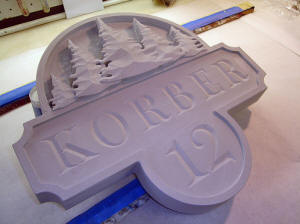 This is a sign we finished carving recently and I decided it would be a good sign to show all the different types of paint that we use and how we put it on layer by layer to create a finished carved sign.
This is a sign we finished carving recently and I decided it would be a good sign to show all the different types of paint that we use and how we put it on layer by layer to create a finished carved sign.
The material we carved the sign from is called Precision Board or high density urethane. It is hard to explain what it actually is or what it feels like, and the best way to explain it would probably be to describe it as a super-dense insulating material. It is a great material to carve with, as it is extremely uniform and will never “surprise” you the way wood will sometimes when you are carving. It is a material that was specially made for the sign industry, and has been in use for over twenty years. This sign is actually carved out of one piece of material. After it is carved we use a primer call Sign Prime (imagine that!) that is specially made for this material that primarily helps the paint bond to it. This sign was already painted with Sign Prime, and tomorrow we will start hitting it with some green…
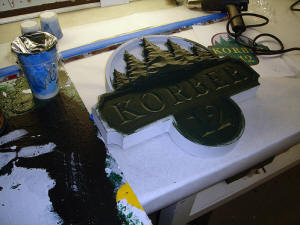
The Sign Prime that we use is a water-based primer (we only use oil based primers when we are working with wood) and we are going to follow up the water based primer with a water based paint. The paint that we put on the majority of our signs is a Latex Outdoor Acrylic Paint, and it is the best quality paint that we can possibly buy. I would say the majority of signs are painted with Oil-Based enamel paints, but Lincoln Sign Company has been using latex paints over 20 years with fantastic results. There are signs that have been out in the field for 5-7 years that we have done that still look as if they had just been painted. The color we are using here is what we call in-house “Dark Green” but is more specifically known in the shop as “Crylite-2-Pumps- Black”. It is the color all of us see when we close our eyes. Yes, we do many, many, MANY green signs here at Lincoln Sign Company, but we do live up in the woods (Brown is a big color as well). If we were located in California I am sure our standard color would be Fuchsia or perhaps Teal.
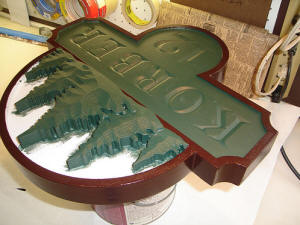
Here is the sign right after Michelle put the first coat of paint on the border. For the border of the sign we use 1-Shot or (One-Shot) Paints. These are the paints that every sign-maker has in their paint cabinet, and they are what we use whenever we hand-letter a sign. The differ from the latex mainly because the have a smooth, glossy finish that levels out very well while drying, and they tend to be thicker so are easier to letter with. I think 1-Shot is the right call the paint the border of this sign, as it will give it a little bit of extra “zip” because it is a high-gloss paint. We will need to hit the border with 2 coats (as we do just about everything with at least two coats). The background green on the sign actually ended up getting about 4 or 5 until we were happy with it.
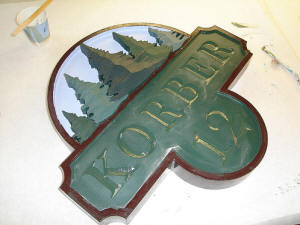
There is quite a bit going on in this picture. The trees have been painted a few different colors of green, and the “sky” background has been painted a purplish-blue. You might notice that the letters seem glossy? That is because Vicki has just painted “Gold Size” onto the letters. Gold size is a “glue” (not really, but we’ll call it that) that will allow real 23K gold to “stick” to the carved letters. Oh, you might notice that there seems to be sand or powder all over the sign. This is so the gold will not stick to the background paint when we leaf it. I am guessing Vicki used baby powder for this sign, as she usually uses that, or a potato (the starch of the potato also can act as a “barrier” to keep gold from sticking)
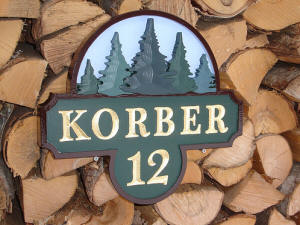
Here is the Korber Sign, completed and hung in our “picture studio” for one last snapshot before it is picked up by its new owner. I was having a conversation with a friend the other day, and we were talking about websites and weblogs, and he asked me why I do the Lincoln Sign Company weblog the way I do (meaning “why do you put such an ungodly amount of time into it every day?”) There are actually, many, many, many answers to this question, but the answer I gave him relates to this sign that we just completed. It is always a pleasure to make a sign for someone, and especially for something as personal as someone’s home. I want to “remember the process” of making this sign, and I want the ability to look back at this sign, years from now, and see the little details about the process that I may have forgotten. I also want that ability for any of the people who have, do, or will work with us at some point, to be able to take someone you care about to this little spot on the Internet and say “you see these trees? I painted those trees”. That might sound like a small thing to some people, but it is my small thing… Now, if you want to see the entire process of making this sign, and other projects like it, you can go to where we tell the stories of how we make our signs…